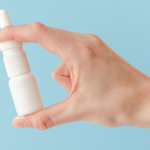
MK-677 & BPC-157: What You Need to Know About these Peptides
February 26, 2025
BPC 157 Nasal Spray: What You Need to Know in 2025
March 6, 2025BPC 157 and Testosterone— Your Questions Answered
BPC-157 has gained significant attention in recent years, especially since Joe Rogan has discussed its potential benefits alongside Testosterone & Growth on his podcast and in other recent appearances.
But what does the science actually say about this peptide’s relationship with hormones? Let’s dive into the research.
What Exactly is BPC-157?
BPC-157 (Body Protection Compound-157) is a synthetic pentadecapeptide composed of 15 amino acids. Originally derived from a protective protein found in gastric juice, it has been studied primarily for its healing properties in various tissues, including:
- Tendons and ligaments
- Skeletal muscle
- Gastrointestinal tract
- Nervous system
Does BPC 157 Increase Testosterone & Growth Hormone? What You Need to Know
One of the most common questions surrounding BPC-157 is whether it increases growth hormone levels. The answer isn’t straightforward.
Growth Hormone Receptor Activation
Research suggests that BPC-157 doesn’t directly increase growth hormone levels in the bloodstream.
Instead, it appears to:
- Enhance growth hormone receptor expression in tendon fibroblasts
- Potentially increase tissue sensitivity to naturally occurring growth hormone
- Promote cell proliferation through this enhanced sensitivity
As one study demonstrated, BPC-157 increased growth hormone receptor expression in tendon fibroblasts, which may contribute to its healing properties by making tissues more responsive to existing growth hormone levels.
Indirect Effects on Growth Factors
Beyond growth hormone receptors, BPC-157 also influences other growth factors:
- Activates vascular endothelial growth factor receptor 2 (VEGFR2)
- Promotes angiogenesis (formation of new blood vessels)
- Accelerates blood flow recovery in ischemic tissues
These effects contribute to BPC-157’s healing properties but don’t necessarily mean it increases growth hormone production itself.
BPC-157 and Testosterone: What We Know
Despite what you might hear in fitness circles or on podcasts like Joe Rogan’s, there’s limited direct research on BPC-157’s effects on testosterone levels.
Current Research Status
The scientific literature doesn’t currently contain strong evidence that BPC-157 directly influences testosterone production.
However, its effects on healing and recovery may indirectly support hormonal health through:
- Improved gut health (which can influence hormone metabolism)
- Reduced systemic inflammation (which can negatively impact hormone production)
- Enhanced recovery from exercise (potentially supporting natural testosterone production)
How BPC-157 Actually Works
Understanding BPC-157’s actual mechanisms helps clarify its relationship with hormones:
Nitric Oxide Pathway
BPC-157 appears to modulate vasomotor tone through:
- Activation of the Src-Caveolin-1-endothelial nitric oxide synthase pathway
- Concentration-dependent nitric oxide generation
- Improved blood flow to tissues
Healing and Recovery Mechanisms
BPC-157’s most well-documented effects involve:
- Accelerated healing of myotendinous junctions
- Prevention of muscle atrophy during recovery
- Effective restoration of tissue function
Systemic Effects
Beyond local healing, BPC-157 demonstrates systemic benefits:
- Counteracting muscle disability
- Reducing local paralysis
- Mitigating hyperkalemia effects
What Joe Rogan and Others Get Right (and Wrong)
Joe Rogan’s mention of BPC-157 alongside testosterone has sparked interest, but it’s important to clarify what’s supported by evidence and what remains speculative.
Accurate Points Often Mentioned:
- BPC-157 promotes healing in various tissues
- It can improve recovery from injuries
- The peptide influences cellular signaling pathways
Claims Lacking Strong Scientific Support:
- Direct increases in testosterone production
- Significant elevation of growth hormone levels
- Hormone-like effects comparable to testosterone replacement
Practical Considerations for BPC-157 Use
If you’re considering BPC-157 based on its potential relationship with hormones, keep these important factors in mind:
Research Status
BPC-157 remains primarily a research peptide with:
- Limited human clinical trials
- No FDA approval for therapeutic use
- Ongoing investigation into long-term effects
Real-World Applications
For those still interested in BPC-157’s potential benefits:
- Focus on its well-documented healing properties
- Consider it for recovery support rather than hormone enhancement
- Maintain realistic expectations based on available evidence
BPC 157, Testosterone, and What’s Next
While BPC-157 shows promising effects on tissue healing, recovery, and certain cellular pathways, the evidence doesn’t currently support claims that it significantly increases growth hormone or testosterone levels.
BPC 157’s benefits appear to be mediated through other mechanisms, primarily involving enhanced tissue sensitivity to growth factors, improved blood flow, and accelerated healing processes.
You can read through several anecdotal threads across various platforms where people reported they took BPC 157 and TB 500 for injuries, and their testosterone levels actually dropped! So for this combo, we’re going to have to hold off on recommending it to boost testosterone.
Our understanding of BPC-157’s relationship with testosterone may evolve as research continues. For now, it’s best to view it primarily as a recovery peptide rather than a hormone-enhancing compound.
Want more info straight to your inbox? Join our newsletter community today!
Disclaimer: This information is for educational purposes only. Always consult with a qualified healthcare provider before starting any new supplement regimen.

